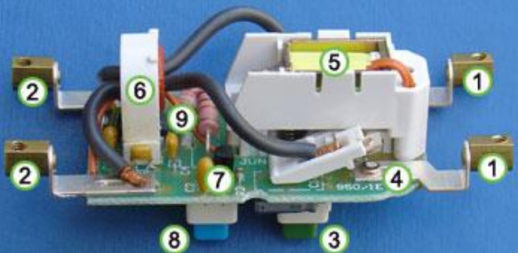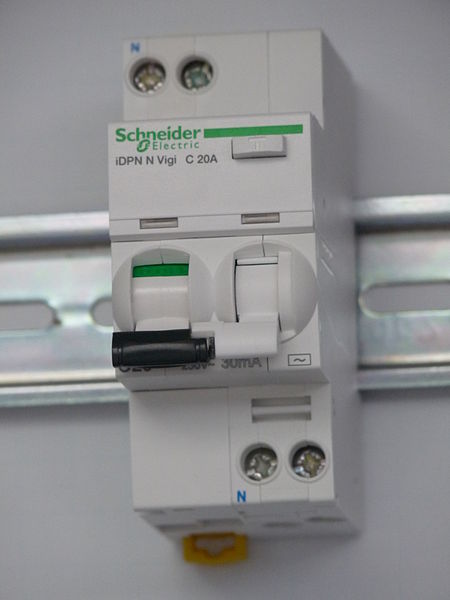RCDs are designed to disconnect the circuit if there is a leakage current. By detecting small leakage currents (typically 5–30 mA) and disconnecting quickly enough (<30 ms), they may prevent electrocution. They are an essential part of the automatic disconnection of supply (ADS), i.e. to switch off when a fault develops, rather than rely on human intervention, one of the essential tenets of modern electrical practice.

The incoming supply and the neutral conductors are connected to the terminals at (1), and the outgoing load conductors are connected to the terminals at (2). The earth conductor (not shown) is connected through from supply to load uninterrupted. When the reset button (3) is pressed, the contacts ((4) and another, hidden behind (5)) close, allowing current to pass. The solenoid (5) keeps the contacts closed when the reset button is released.
The sense coil (6) is a differential current transformer which surrounds (but is not electrically connected to) the live and neutral conductors. In normal operation, all the current down the live conductor returns up the neutral conductor. The currents in the two conductors are therefore equal and opposite and cancel each other out.
Any fault to earth (for example caused by a person touching a live component in the attached appliance) causes some of the current to take a different return path, which means that there is an imbalance (difference) in the current in the two conductors (single-phase case), or, more generally, a nonzero sum of currents from among various conductors (for example, three phase conductors and one neutral conductor).
This difference causes a current in the sense coil (6), which is picked up by the sense circuitry (7). The sense circuitry then removes power from the solenoid (5), and the contacts (4) are forced apart by a spring, cutting off the electricity supply to the appliance.
The test button (8) allows the correct operation of the device to be verified by passing a small current through the orange test wire (9). This simulates a fault by creating an imbalance in the sense coil. If the RCD does not trip when this button is pressed, then the device must be replaced.
To prevent electrocution, RCDs should operate within 25–40 milliseconds with any leakage currents (through a person) of greater than 30 mA, before electric shock can drive the heart, the most common cause of death through electric shock. By contrast, conventional circuit breakers or fuses only break the circuit when the total current is excessive (which may be thousands of times the leakage current an RCD responds to). A small leakage current, such as through a person, can be a very serious fault, but would probably not increase the total current enough for a fuse or circuit breaker to break the circuit, and certainly not do so fast enough to save a life.

RCDs operate by measuring the current balance between two conductors using a differential current transformer. This measures the difference between current flowing through the live conductor and that returning through the neutral conductor. If these do not sum to zero, there is a leakage of current to somewhere else (to earth/ground or to another circuit), and the device will open its contacts. Operation does not require a fault current to return through the earth wire in the installation; the trip will operate just as well if the return path is through plumbing, contact with the ground or any other current path. Automatic disconnection and a measure of shock protection is therefore still provided even if the earth wiring of the installation is damaged or incomplete.
For an RCD used with three-phase power, all three live conductors and the neutral (if fitted) must pass through the current transformer.
Application
Electrical plugs with incorporated RCD are sometimes installed on appliances that might be considered to pose a particular safety hazard, for example long extension leads, which might be used outdoors, or garden equipment or hair dryers, which may be used near a bath or sink. Occasionally an in-line RCD may be used to serve a similar function to one in a plug. By putting the RCD in the extension lead, protection is provided at whatever outlet is used even if the building has old wiring, such as knob and tube, or wiring that does not contain a grounding conductor.
In North America, GFI receptacles can be used in cases where there is no grounding conductor, but they must be labeled as “ungrounded”. An ungrounded GFI receptacle will trip using the built-in “test” button, but will not trip using a GFI test plug, because the plug tests by passing a small current from line to the non-existent ground.
In Europe, RCDs can fit on the same DIN rail as the MCBs; however, the busbar arrangements in consumer units and distribution boards can make it awkward to use them in this way.
Electrical sockets with included RCDs are becoming common.
RCBO
A pure RCD will detect misbalance in the currents of the supply and return conductors of a circuit. But it cannot protect against overcurrent (overload) or short circuit like a fuse or a miniature circuit breaker (MCB) does (except for the special case of a short circuit from live to ground (not live to neutral)).
However, a RCD and a MCB often come integrated in the same device, thus being able to detect both supply imbalance and overload current. Such a device is called
- RCBO (for residual-current circuit breaker with overcurrent protection ) in Europe
- GFCI breaker (for ground fault circuit interrupter ) in USA and Canada and
-
Safety Switch or RCD in Australia.
Reference Wikipedia
